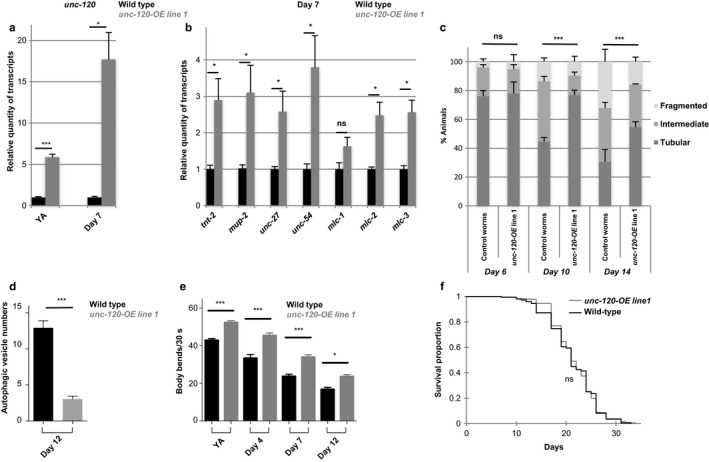Figure 4.

Muscle‐specific unc‐120 over‐expression is sufficient to delay muscle aging without extending lifespan. (a–b) Relative quantity of (a) unc‐120 or (b) muscle genes transcripts measured in wild‐type (WT) or unc‐120 overexpressing worms (unc‐120‐OE) at young adult (YA) stage and at day 7 of adulthood. For each gene, results were normalized to the WT level and expressed in relative units. Bars are mean ± SEM (n = 8 and 4, respectively, for YA and day 7 of adulthood), Mann–Whitney test. (c) Quantification of animals with the indicated muscle mitochondria phenotypes among WT or unc‐120 overexpressing worms (unc‐120‐OE) at different ages during adulthood. n = 100, 123, and 93 for control worms and n = 100, 117, and 121 for unc‐120‐OE worms, at day 6, 10, and 14, respectively. Data are presented as mean ± SEM, chi‐square test. (d) Number of autophagic vesicles per muscle cell at day 12 of adulthood in WT or unc‐120 overexpressing worms (unc‐120‐OE). Number of animals scored: n = 77 and 79 for WT and unc‐120‐OE worms, respectively. Data are mean ± SEM, Mann–Whitney test. (e) Body bend frequency of WT or unc‐120 overexpressing worms (unc‐120‐OE) at different ages during adulthood. n = 140, 58, 108, and 112 for control worms and n = 123, 86, 152, and 130 for unc‐120‐OE worms, at YA stage and days 4, 7, and 12, respectively. Bars are mean ± SEM, Kruskal–Wallis and Dunn's post hoc test. (f) Survival curves of WT or unc‐120 overexpressing worms (unc‐120‐OE). The corresponding average lifespans were 21.2 ± 0.3 days (n = 245) and 21.6 ± 0.2 days (n = 372) for WT and unc‐120‐OE worms, respectively. Five independent experiments have been pooled
